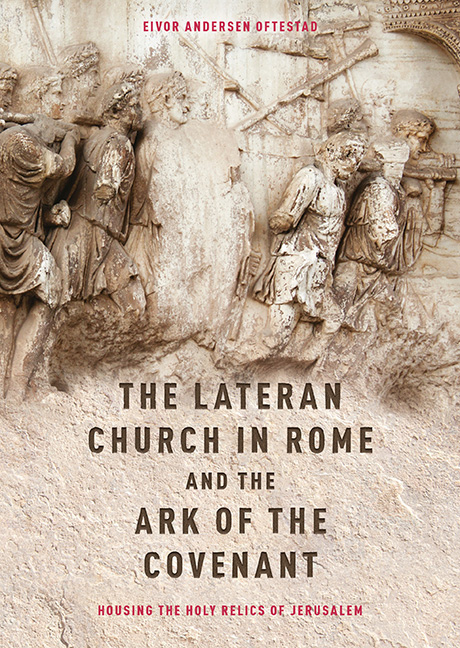 The Lateran Church in Rome and the Ark of the Covenant: Housing the Holy Relics of Jerusalem
The Lateran Church in Rome and the Ark of the Covenant: Housing the Holy Relics of Jerusalem Book contents
- Frontmatter
- Dedication
- Contents
- List of Tables
- Acknowledgements
- List of Abbreviations
- Author's Note
- Prologue
- 1 Introduction
- 2 The Description of the Lateran Church
- 3 In the Roman Context
- 4 In the Northern French Context
- 5 In the Jerusalem Context
- 6 The Temple of the New Covenant
- 7 Nikolaus Maniacutius and John the Deacon
- Epilogue
- Appendix 1 Manuscripts Transmitting the Descriptio Lateranensis Ecclesiae
- Appendix 2 Different Versions of the Descriptio Lateranensis Ecclesiae
- Appendix 3 Edition and Translation of the Descriptio Lateranensis Ecclesiae (Reg. lat. 712)
- Bibliography
- Index
- Other volumes in Studies in the History of Medieval Religion
7 - Nikolaus Maniacutius and John the Deacon
Published online by Cambridge University Press: 31 August 2019
- Frontmatter
- Dedication
- Contents
- List of Tables
- Acknowledgements
- List of Abbreviations
- Author's Note
- Prologue
- 1 Introduction
- 2 The Description of the Lateran Church
- 3 In the Roman Context
- 4 In the Northern French Context
- 5 In the Jerusalem Context
- 6 The Temple of the New Covenant
- 7 Nikolaus Maniacutius and John the Deacon
- Epilogue
- Appendix 1 Manuscripts Transmitting the Descriptio Lateranensis Ecclesiae
- Appendix 2 Different Versions of the Descriptio Lateranensis Ecclesiae
- Appendix 3 Edition and Translation of the Descriptio Lateranensis Ecclesiae (Reg. lat. 712)
- Bibliography
- Index
- Other volumes in Studies in the History of Medieval Religion
Summary
I do not have the gold of intelligence and the silver of eloquence, or the precious stones of virtue, I wish to offer Your Holiness, in memory of this sanctuary, ram skin depicted and rubricated …
Nikolaus Maniacutius: Historia Imaginis Salvatoris
The images in the Lateran Church and in the papal chapel showed who inhabited the sanctuaries. In a passionary preserved in Santa Maria Maggiore in Rome, we find a peculiar sermon concerning the most important image at the Lateran, which was the image of the Saviour in the oratory of San Lorenzo (c. 1145). The sermon is ascribed to Nikolaus Maniacutius and describes a vision of a most extraordinary procession of saints, confessors, martyrs and apostles, followed by the glorious mother of God, all of whom enter the papal chapel. The spectator, a penitent praying outside the chapel, is told by angels that what he is seeing is the return visit of the mother of God after her Son had visited her on the Feast of the Assumption. After the entrance of saints, a fire fills the palace as if it were being consumed by flames. The spectator is astonished and afraid, but the angels comfort him:
‘Don't be afraid. This is the glory of God who is about to enter.’ Comforted by their words, he then lifted his eyes and saw the glorious throne of the great God being lifted up by the angels of God, but he saw no one sitting on the throne. As soon as the doors of this holy basilica had been opened, he was led to the heavenly thrones.
The vision described by Maniacutius is clearly modelled on the visions of God in his temple described in the Old Testament, especially in Ezekiel's vision of the return of the glory of God to the new temple. Maniacutius’ description seems to correspond with the idea that the papal private chapel can be regarded as the Holy of Holies in the temple of the New Covenant.
In the passionary the sermon is placed between other texts connected to the dedication feast of the Lateran Church: ‘Legend on the Church of the Saviour’ (‘Legenda Ecclesie Salvatoris’), the legend about the miracle of Beirut (‘De Passione Ymaginis Domini Salvatoris’) and ‘The Vengeance of the Lord’ (‘Vindicta Domini’).
- Type
- Chapter
- Information
- The Lateran Church in Rome and the Ark of the Covenant: Housing the Holy Relics of JerusalemWith an Edition and Translation of the Descriptio Lateranensis Ecclesiae (Bav Reg. Lat. 712), pp. 157 - 186Publisher: Boydell & BrewerPrint publication year: 2019


